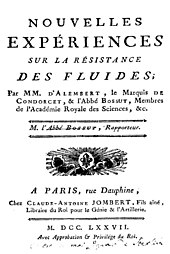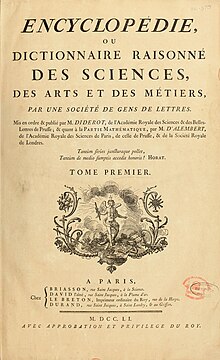Jean le Rond d'Alembert
Jean le Rond D'Alembert or Jean Le Rond d'Alembert (French pronunciation: /ʒɑ̃ batist lə ʁɔ̃ dalɑ̃bɛːʁ/; Paris, November 16, 1717-Paris, October 29, 1783) was a French mathematician, philosopher and encyclopedist, one one of the greatest exponents of the Enlightenment movement. He was famous for creating —with Diderot— L & # 39; Encyclopédie and for his work in the field of mathematics, relating to differential equations and partial derivatives.
Biography
Jean le Rond D'Alembert was born on November 16, 1717 in Paris, France, the illegitimate son of Madame de Tencin and Louis-Camus Destouches, the little d'Alembert, newborn in 1717, was abandoned at the door of the church of Saint-Jean-le Rond (hence the name given to it). He was later picked up by Madame Rousseau, a poor woman, who took care of his upbringing. D & # 39; Alembert, who initially called himself Daremberg, was never recognized by his parents, but Destouches covered the costs of his education, which could be as select as that of any son of the nobility.
At the age of 18, he obtained a bachelor's degree in arts, after several years of study at a Jansenist school. After two years of studying law, he began to study medicine, which he soon abandoned.
d'Alembert's great passion was mathematics, which he had learned almost self-taught. In 1739, he presented his first paper at the prestigious Academy of Sciences in Paris. Two years later, at just 24 years of age, he was elected a member of that Academy. In 1743 he published his Treatise on Dynamics, a fundamental work in which he formulated the well-known d'Alembert principle, which confirms the existence of inertia in a material point, as a reaction exerted by that point against the forces acting on it. With her, the young d'Alembert immediately achieved prestige throughout Europe, as one of the most renowned scientific thinkers; Lagrange, for example, will affirm that this treatise «reduces dynamics to statics».
The philosopher d'Alembert continued to produce new works in the field of mathematical physics, including the titled Treatise on the equilibrium and movement of fluids. In 1746, together with Diderot he was commissioned to translate the Cyclopaedia of Ephraim Chambers. In 1747 he began the preparation of the Encyclopedia , collaborating closely.
In the year 1772 he was appointed perpetual secretary of the French Academy, then writing the Elogi about the academics who died between 1700 and 1770. For all this d'Alembert represented a new type of intellectual capable of combining belonging to the new international network of scientific institutions (on the other hand financially subordinated to nation-states) and independent and politically committed essayism.
He died in Paris on October 29, 1783 at the age of 65, when he already enjoyed the reputation of being one of the most eminent thinkers of the French Enlightenment. He was modestly buried. Condorcet, his friend and successor in certain mathematical fields, accompanied his funeral procession. He also praised him at the Academy, since he had received that position from d & # 39; Alembert.
Encyclopedia
In 1750, and always together with Diderot, who was the inspiration, the publication of the Encyclopedia began. The idea of translating Chambers' English work quickly became an original project of adaptation and progressive expansion, soon leaving the initial dependence on him.
D'Alembert wrote many articles on mathematics and literature, in addition to the Preliminary Discourse. Philosophers such as Voltaire, Montesquieu, Jean-Jacques Rousseau, Adam Smith, among others, also participated in the Encyclopedia.
The break with Diderot, in 1758, meant that he would deal alone with the job of directing the Encyclopedia, although Diderot did not forget his polemics with the increasingly rationalist mathematician in an original e ironic pre-biological dialogue: d'Alembert's dream. But, as Franco Venturi says, d'Alembert contributed in a very personal way to that work. In any case, he had an encyclopedic mentality, which is evidenced by the fact that, at the end of his life, he wrote a personal Memoria telling how he loved letters.
D'Alembert in the prologue to the Encyclopedia wrote the following:
We cannot expect to know nature by vague and arbitrary hypotheses, but by the reflective study of phenomena, by the comparison we will make with each other, by the art of reducing, to the extent possible, a large number of phenomena to one that can be looked at as its principle.D' Alembert: Preliminary Address to the Encyclopedia (1751) (fragment)
D'Alembert also wrote most of the articles on mathematics, astronomy and physics. He wrote (under the signature O ) about 1700 articles, most of them related to mathematics in the broad sense but significantly reduced the level of his involvement since 1762.
D'Alembert is one of four writers of articles on astronomy, along with Jean-Baptiste Le Roy, Johann Heinrich Samuel Formey and Louis de Jaucourt. He provides evidence for heliocentrism with the new arguments from Newtonian mechanics. Adopting a militant tone, he does not miss the opportunity to mock the ecclesiastics and harshly criticizes the Inquisition, judging in the Preliminary Discourse that "the abuse of spiritual authority combined with temporal authority forced the reason to silence; and almost forbade the human race to think."
"Think after yourself" and "think for yourself", formulas that have become famous, are due to d'Alembert; they are found in the Preliminary Discourse, Encyclopedia, volume 1, 1751. These formulations are a resumption of the ancient mandates (Hesiod, Horace).
Philosophy and mathematics
His philosophy was characterized by his tolerance in general and his skepticism in the field of religion and metaphysics. He specialized in natural philosophy and wrote the Preliminary Discourse of the Encyclopédie directed by Denis Diderot. Illustrious philosopher, his thought is influenced by Descartes, Bacon, Newton and Locke. He expounded his doctrine in Elements of Philosophy .
He approached mathematics through physics, with the problem of the three bodies (impossibility of finding equations of the trajectories - instability of the system), the precession of the equinoxes (reason for the sliding of the seasons), vibrating strings (different modes of vibration - application to music). This led him to study differential equations and equations to partial derivatives. He also invented a criterion to distinguish a convergent series from a divergent one.
His masterpiece was the Treatise on Dynamics, where he stated the theorem that bears his name (d'Alembert's principle). The Fundamental Theorem of Algebra receives in some European countries the name d'Alembert - Gauss theorem, since d'Alembert was the first to give an almost complete proof of said theorem.
Music
D'Alembert is considered a music theorist, particularly on Éléments de musique. A controversy opposed him on this subject to Jean-Philippe Rameau.
By studying the vibration of strings, he was able to show that the motion of a vibrating string is represented by a partial differential equation and indicated the general solution of this equation. This vibrating string equation was the first example of the wave equation. This makes d'Alembert one of the founders of mathematical physics. His work was at the origin of fruitful polemics when Leonhard Euler, following Daniel Bernoulli, had given, in the form of a trigonometric series, a solution to the equation of vibrating strings that seemed totally different from that of d & # 39; Alembert. From the discussion it turned out that the trigonometric solution could be adapted to represent an arbitrary initial shape of the chord.
Works
His complete works were republished in 1805 by Jean-François Bastien and in 1821-1822 by editor Belin and Martin Bossange. These editions that are presented as complete actually present quite a few gaps in much of the scientific writings and correspondence, in addition to publishing apocrypha. Since 1992, his Complete Works have been published by Éditions du CNRS, in five series: Treatisees, notebooks and mathematical memoirs (this set forms two series separated by the fundamental year 1757); Encyclopedia Articles (this series would be merged with the collaborative critical edition of the Encyclopedia ENCCRE); Philosophical, historical and literary writings and General correspondence.
- Scientific and mathematical texts:
- Mémoire sur le calcul intégral (Memories about the integral calculation(1739), first published work
- Mémoire sur la réfraction des corps solides (Memory on solid body refraction(1740)
- I brought dynamique (Dynamics Treaty(1743 later 1758) (National Library of France: 35209593s)
- Opuscules mathématiques (Mathematical booklets(8 volumes, 1761-1780) (National Library of France: 300091553)
- Traité de l'équilibre et du mouvement des fluides: pour serve de suite au Traité de dynamique (Treaty on the Balance and Movement of Fluids: as a continuation of the Treaty on Dynamics(1744) (National Library of France: 37366950k)
- Réflexions sur la causa générale des vents (Reflections on the general cause of winds), recorded by Jean-Baptiste Delafosse according to Charles Eisen; (1747, Paris, Michel-Antoine David) (National Library of France: 30009159g)
- Surrenders the vibrant cords (Vibrant rope research(1747)
- Recherches sur la précession des équinoxes et sur la nutation de l'axe de la terre (Research on the precession of the equinoxes and on the nourishment of the axis of the earth(1749)
- Non-scientific texts: these texts were often re-edited and re-elaborated by d'Alembert and relate to several topics: praises read at the French Academy, speeches and apologies, articles, book reviews, translations... Jean-Daniel Candaux made an alphabetical directory http://dalembert.academie-sciences.fr/Pdf/SerieIV-DA-biblio.pdf (2004)].
- Discours préliminaire de l'Encyclopédie (Preliminary Speech of the Encyclopedia(1751)
- Eléments de musique (Elements of music(1752)
- Mélanges de littérature, d'histoire et de philosophie (Mixes of literature, history and philosophy(1753 1a. ed. in 2 volumes, 1759 2.a ed. in 4 volumes and then add a volume 5 in 1767). 5 volumes in a volume, Paris, ed. Garnier Classics, 2018, 1245 p. ISBN 978-2-406-06362-9
- Recherches sur différens points importans du système du monde (Research on different important points of the world system) (1st part, Paris, chez David l'aîné, 1754), (2nd part, Paris, David, 1754), (3rd part, Paris David, 1756)
- Essai sur les éléments de philosophie (Testing on the elements of philosophy(1759)
- Sur la destruction des jésuites en France, par un sieur désintéressé, pamphlet (About the destruction of the Jesuits in France, by a disinterested sieur, pamphlet(1765-1767)
- Encyclopédie ou Dictionnaire raisonné des sciences, des arts et des métiers (Enciclopedia o Diccionario Razonado de Ciencias, Artes y Oficios), Flammarion, (1993) ISBN 2-080704265.
- Letters: the complete works of the CNRS bring together a corpus of 2200 letters of d'Alembert, more than twice the correspondence of Diderot.
 Wikisource contains original works of or about Jean le Rond d'Alembert. — Letters published by Gaston Maugras.
Wikisource contains original works of or about Jean le Rond d'Alembert. — Letters published by Gaston Maugras.
- Correspondence with Federico the Great, ed. Preuss, (Berlin, Duncker 1854, et al..)
Eponymy
- The lunar crater d'Alembert bears this name in his honor.
Additional bibliography
- Nicolas de Condorcet (1786). Eloge de M. d'Alembert, Histoire de l'Académie royale des sciences - Année 1783 (in French). Paris: Imprimrie royale. pp. 76-120..
- Martine Groult, D’Alembert et la mécanique de la vérité dans l'Encyclopédie, Paris, Champion, 1999, 505 p. ISBN 2-7453-0048-2. (in French)
- François Moureau, Le Roman vrai de l'Encyclopédie, Paris, Gallimard, 1990, 224 p., ill. (collection «Découvertes Gallimard », n.o 100 (2.a revised edition 2001).(in French)
- Michel Paty, D'Alembert ou la raison physico-mathématique au siècle des LumièresParis, Belles-Lettres, 1998. (in French)
- Michel Paty, Analyse et dynamique: études sur l'œuvre de d'AlembertPresses de l'Université de Laval, 2002. (in French)
- Bernard, Jonathan W. (1980). «The Principle and the Elements: Rameau's Controversy with D'Alembert». Journal of Music Theory (in English) 24 (1): 37-62. JSTOR 843738. doi:10.2307/843738.
- Briggs, J. Morton (1970). "Jean le Rond d'Alembert". Dictionary of Scientific Biography (in English) 1. New York: Charles Scribner's Sons. pp. 110-117. ISBN 0-684-10114-9.
- Christensen, Thomas (1989). «Music Theory as Scientific Propaganda: The Case of D'Alembert's Élémens [The Case of D'Alembert's Elémens]sicDe Musique. Journal of the History of Ideas (in English) 50 (3): 409-27. JSTOR 2709569. doi:10.2307/2709569.
- Crépel, Pierre (2005). "I brought dynamique." In Grattan-Guinness, I., ed. Landmark Writings in Western Mathematics. Elsevier. pp. 159-67. (requires registration).
Contenido relacionado
Pseudoscience
UNIX
Annex: History of Microsoft Windows


